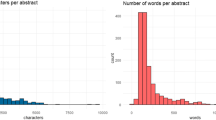Abstract
What are the mechanisms underlying the reproduction and change of collective beliefs? The paper suggests that a productive and promising approach for dealing with this question can be found in ontogenetic and cross-cultural studies on ‘collective argumentations and belief systems’; this is illustrated with regard to moral beliefs: After a short discussion of the rationality/relativity issue in cultural anthropology some basic elements of a conceptual framework for the empirical study of collective argumentations are outlined. A few empirical case studies are summarized; the results deliver some empirical evidence to the assumption that as the ‘logic of collective argumentations’ develops in children and adolescent there will be different and increasingly more complex constraints on the kinds of basic moral beliefs that can be collectively accepted. Most importantly, as children approach adolescence they may have acquired a ‘logic of argumentation’ which makes possible a collectively valid distinction between the ‘is’ and the ‘ought’ of some disputed particular moral issue. A comparison with a land litigation among Trobriands (Papua New Guinea) shows that the ‘logic of argumentation’ and the corresponding basic moral beliefs of Trobriands very much resemble the ‘logic of argumentation’ and moral rationality standards of (German) adolescents.
Similar content being viewed by others
Bibliography
Barnes, B. and D. Bloor: 1982, ‘Relativism, Rationalism and the Sociology of Knowledge’, in M. Hollis and S. Lukes (eds.), Rationality and Relativism, Basil Blackwell, Oxford. pp. 21–47.
Bloch, M.: 1974, ‘Symbols, Song, Dance and Features of Articulation: Is Religion an Extreme Form of Traditional Authority?’, Europäishes Archiv für Soziologie 15, 55–81.
Bourdieu, P.: 1979, La distinction. Critique sociale du jugement, Les Editions de Minuit, Paris.
Campbell, D. T., M. H. Segall and M. J. Herskovits: 1966, The Influence of Culture on Visual Perception, Bobbs Merill, Indianapolis.
Canetti, E.: 1935, Die Blendung, Herbert Reichner, Verlag, Wien.
Castañeda, H.-N.: 1974, The Structure of Morality, Charles C. Thomas Publisher, Spring-field, Ill.
Cole, M. and S. Scribner: 1974, Culture and Thought, Wiley, New York.
Douglas, M.: 1970, Natural Symbols, London.
Durkheim, E.: 1930, De la division du travail social, Presses Universitaires de France, Paris.
Enzensberger, H. M.: 1965, ‘Anleitung zum besseren Verstänis von Lorenz Okens kombinatorischem System der Pflanzewelt’, Kursbuch 3, 79–81.
Evans-Pritchard, E.E.: 1937, Witchcraft, Oracles and Magic among the Azande, Oxford.
Fallers, L. A.: 1969, Law without Precedent — Legal Ideas in Action in the Courts of Colonial Busoga, Chicago University Press, Chicago.
Feffer, M.: 1959, ‘The Cognitive Implications of Role-Taking Behavior’, Journal of Personality 27, 152–168.
Feffer, M.: 1970, ‘A Developmental Analysis of Interpersonal Behavior’, Psychological Review 77, 197–214.
Flavell, J. H., C. Fry, J. Wright and P. Jarvis: 1968, The Development of Role-Taking and Communication Skills in Children, Wiley, New York.
Habermas, J.: 1983, Moralbeweβtsein und kommunikatives Handeln, Suhrkamp, Frankfurt.
Hesse, M.: 1980, Revolutions and Reconstructions in the Philosophy of Science, Harvester, Hassocks.
Hutchins, E.: 1980, Culture and Inference, Harvard University Press, Cambridge, Mass.
Keesing, R. M.: 1981, Cultural Anthropology, Holt, Rinehart & Winston, New York.
Klahr, D. and R. S. Siegler: 1978, ‘The Representation of Children's Knowldge’, in H. W. Reese and L. P. Lipsit (eds.), Advances in child development, Academic Press, New York, pp. 61–116.
Klein, W.: 1980, ‘Argumentation und Argument’, in W. Klein (ed.), Argumentation, Zeitschrift für Literaturwissenschaften und Linguistik 38/39, 9–57.
Kohlberg, L.: 1981, The Philosophy of Moral Development, Harper & Row, San Francisco.
Laboratory of Comparative Human Cognition: 1982, ‘Culture and Intelligence’, in R. J. Sternberg (ed.), Handbook of Human Intelligence, Cambridge University Press, Cambridge, pp. 642–719.
Luhmann, N.: 1984, Soziale Systeme, Suhrkamp, Frankfurt.
Mead, G. H.: 1934, Mind, Self and Society, Chicago University Press, Chicago.
Miller, M.: 1979, The Logic of Language Development in Early Childhood, Springer, New York/Berlin.
Miller, M.: 1986a, Kollektive Lernprozesse — Studien zur Grundlegung einer soziologischen Lerntheorie, Suhrkamp, Frankfurt.
Miller, M.: 1986b, ‘Argumentation and Cognition’, in M. Hickmann (ed.), Social and Functional Approaches to Language and Thought, Academic Press, New York (in press).
Miller, M.: 1986c, ‘Learning How to Contradict and Still Pursue a Common End — the Ontogenesis of Moral Argumentation’, in J. Cook-Gumperz, W. Corsaro and J. Streeck (eds.), Children's worlds and children's language, Mouton, Berlin (in press).
Oken, L.: 1825, Lehrbuch der Naturgeschicht, August Schmid Verlag, Jena.
Parsons, T. and E. A. Shills: 1951, Toward a General Theory of Action, Harvard University Press, Cambridge, Mass.
Piaget, J.: 1932, Le jugement moral chez l'enfant, Presses Universitaires de France, Paris.
Rospisil, L.: 1971, Anthropology of Law, Harper & Row, New York.
Rawls, J.: 1971, An Theory of Justice, Harvard University Press, Cambridge, Mass.
Saxe, G. B.: 1979, ‘A Comparative Analysis of the Acquisition of Numeration: Studies from Papua New Guinea’, Quarterly Newsletter of the Laboratory of Comparative Human Cognition 3, 37–43.
Selman, R. L.: 1975, ‘Social-Cognitive Understanding: a Guide to Educational and Clinical Practice’, in T. Lickona (eds.), Moral Development and Behavior, Holt, Rinehart & Winston, New York, pp. 299–316.
Selman, R. L.: 1980, The Growth of Interpersonal Understanding, Academic Press, New York.
Senft, G.: 1985, ‘How to Tell and Understand a Dirty Joke in Kilivila’, Journal of Pragmatics 9, 217–236.
Toulmin, S.: 1958, The Uses of Argument, Cambridge University Press, New York.
Waller, M.: 1978, Soziales Lernen und Interaktionskompetenz, Klett Verlag, Stuttgart.
Wesel, U.: 1985, Früformen des Rechts in vorstaatlichen Gesellschaften, Suhrkamp, Frankfurt.
Author information
Authors and Affiliations
Additional information
This paper was presented at a symposium of the Max-Planck-Society on Cognitive Anthropology at Ringberg Castle, May 12–14, 1986. The aim of the symposium was to suggest possible research topics for an interdisciplinary project on ‘belief systems’ carried out by cognitive scientists and cultural anthropologists.
Rights and permissions
About this article
Cite this article
Miller, M. Culture and collective argumentation. Argumentation 1, 127–154 (1987). https://doi.org/10.1007/BF00182257
Issue Date:
DOI: https://doi.org/10.1007/BF00182257




